
Dropped vs Expired Domains: What's the Difference and Why It Matters
In today’s online world, domain names are more than just web addresses they’re important digital assets. A good domain can shape a brand’s image, help it show up in search results, and even be worth a lot if resold. But as the domain market has grown, understanding what happens when domains aren’t renewed or looked after has become more confusing.
Two terms that often trip people up are "expired domains" and "dropped domains." They sound alike, but they actually refer to very different points in a domain’s life, and each comes with its own risks and opportunities for website owners, investors, and SEO experts.
In this article, we’ll explain the difference between expired and dropped domains, walk you through the domain life cycle, and help you see why this difference matters whether you want to get back an old website, invest in a promising domain, or avoid mistakes when buying one.

What Are Expired Domains?
An expired domain is a domain name whose registration period has run out because the owner didn’t renew it before the deadline. Usually, domains are registered for anywhere between one and ten years. When that time is up and the owner doesn’t take action to renew, the domain moves into what’s called an expired status.

But just because a domain expires doesn’t mean it immediately becomes available for anyone to grab. Instead, it goes through a few important stages:
- Grace Period: Most domain registrars offer a grace period, usually lasting from 0 to 45 days after expiration. During this time, the original owner can still renew the domain at the regular price without paying any extra fees.
- Redemption Period: If the grace period passes without renewal, the domain often enters what’s called a redemption phase, usually lasting about 30 days. The owner can still get the domain back during this time, but they’ll usually need to pay a redemption fee in addition to the normal renewal cost.
- Pending Delete: After the redemption period ends, the domain moves into a pending delete phase. This stage typically lasts 5 to 7 days. Once it’s over, the domain is removed from the registry and becomes available to the public this is when it’s known as a dropped domain.
Why do domains expire?
There are a few common reasons why domains end up expiring:

- The owner simply forgot to renew it and missed the deadline.
- The owner no longer needs the domain because the project, website, or business it was tied to has ended.
- The payment method on file failed, so the renewal didn’t go through.
- The owner decided to abandon the domain, either because they lost interest or shifted their focus to something else.
What Are Dropped Domains?
A dropped domain is a domain name that has gone through its entire expiration process including the grace period, redemption period, and pending delete phase and has been fully released back into the public pool. Once it reaches this stage, the domain is no longer tied to its previous owner and is open for anyone to register, usually on a first-come, first-served basis.

Here’s a simple overview of how a domain moves from expiration to being dropped:
- Expiration: The domain’s registration period comes to an end, and the domain becomes inactive or stops working online.
- Grace Period (0–45 days): The original owner still has a chance to renew the domain without paying extra fees.
- Redemption Period (about 30 days): The owner can still recover the domain, but now they have to pay a higher redemption fee to get it back.
- Pending Delete (around 5–7 days): The domain is locked in for deletion. At this point, the owner can no longer recover it, and the domain is waiting to be cleared from the registry.
- Drop Day: The domain is officially removed from the registry and becomes available for anyone to register.
Once a domain has dropped, no one owns it anymore. This opens the door for businesses, individuals, or domain investors to snap it up. In fact, many investors use drop-catching tools or services to quickly grab valuable domains the moment they’re released.
Why Do Domains Get Dropped?
Domains can be dropped for a number of reasons:

- The owner no longer wanted it: Sometimes, people or businesses simply lose interest in keeping the domain.
- The domain lost value: Over time, a domain may no longer have commercial or SEO importance, making it less worth keeping.
- Legal or trademark issues: There may be legal concerns or trademark problems that make renewing the domain too risky or complicated.
- The related website shut down: If the website connected to the domain has permanently closed, the owner may see no reason to keep paying for it.
Key Differences Between Dropped and Expired Domains
While expired domains and dropped domains both refer to domains that have passed their renewal date, they represent very different stages in the domain lifecycle. Understanding these differences is crucial whether you’re reclaiming a domain, buying one for SEO, or investing.
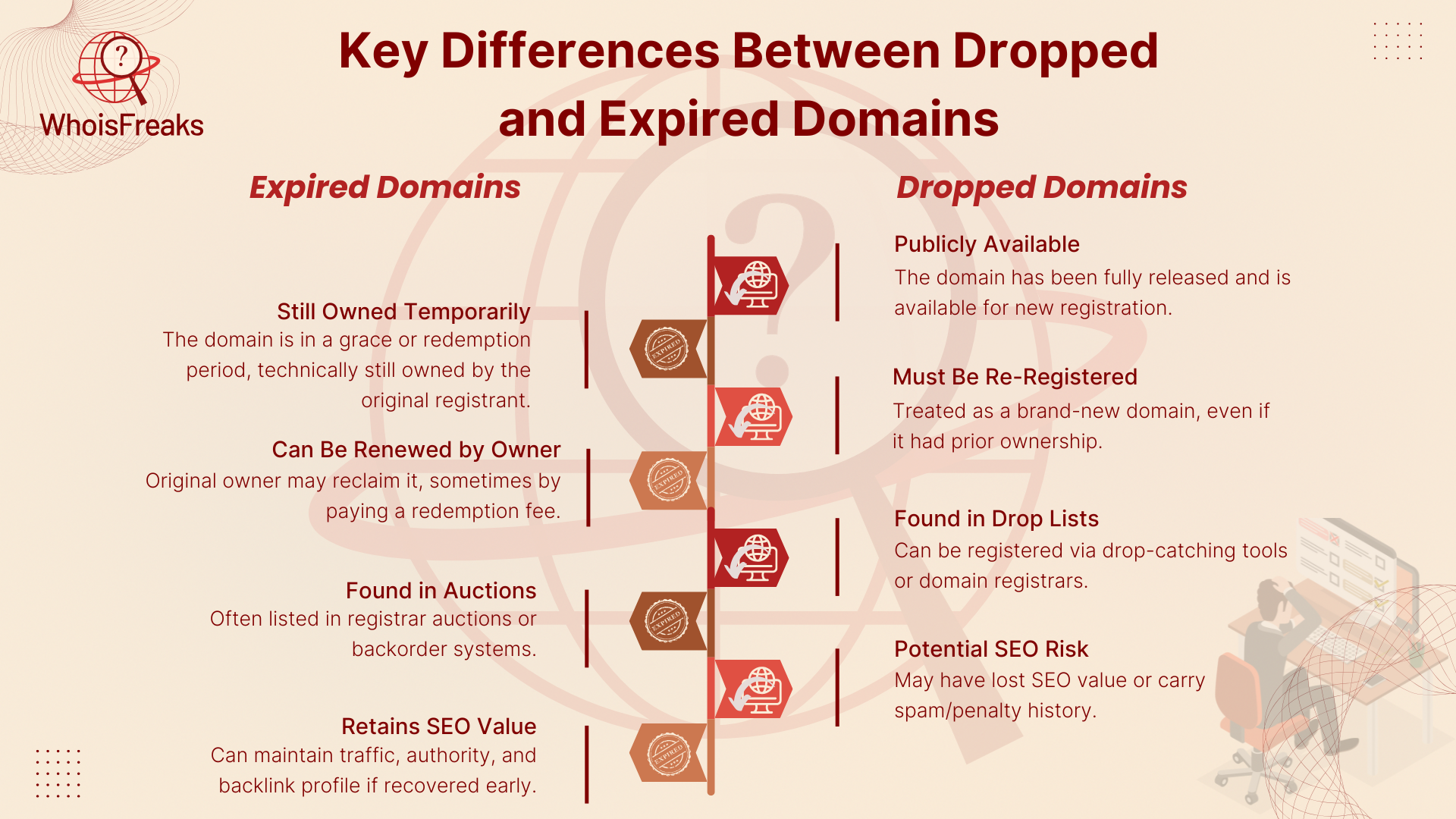
| Aspect | Expired Domains | Dropped Domains |
|---|---|---|
| Ownership Status | Still technically owned by the original registrant (during grace/redemption period) | No longer owned; available to the public |
| Renewal Possibility | Can usually be renewed by the original owner (sometimes with a fee) | Cannot be renewed; must be re-registered like a new domain |
| Availability | Not publicly available; may appear in auctions | Fully available for public registration (first-come, first-served) |
| Where to Find | Domain auctions, registrar backorder lists | Drop-catching services, domain registrars, drop lists |
| SEO & Backlink Profile | Often retains SEO value, traffic, and backlinks if recovered early | May have lost some SEO value but can still have residual authority |
| Pricing | Auction prices or redemption fees (can be expensive) | Standard domain registration price (plus drop-catching service fees if used) |
| Risk Factors | Risk of auction competition; original owner may still reclaim | Risk of losing SEO value; possible history of spam or penalties |
Why the Difference Matters
Understanding the difference between expired and dropped domains isn’t just some technical detail it can really affect your strategy, depending on what you’re trying to achieve. Here’s why it’s important:
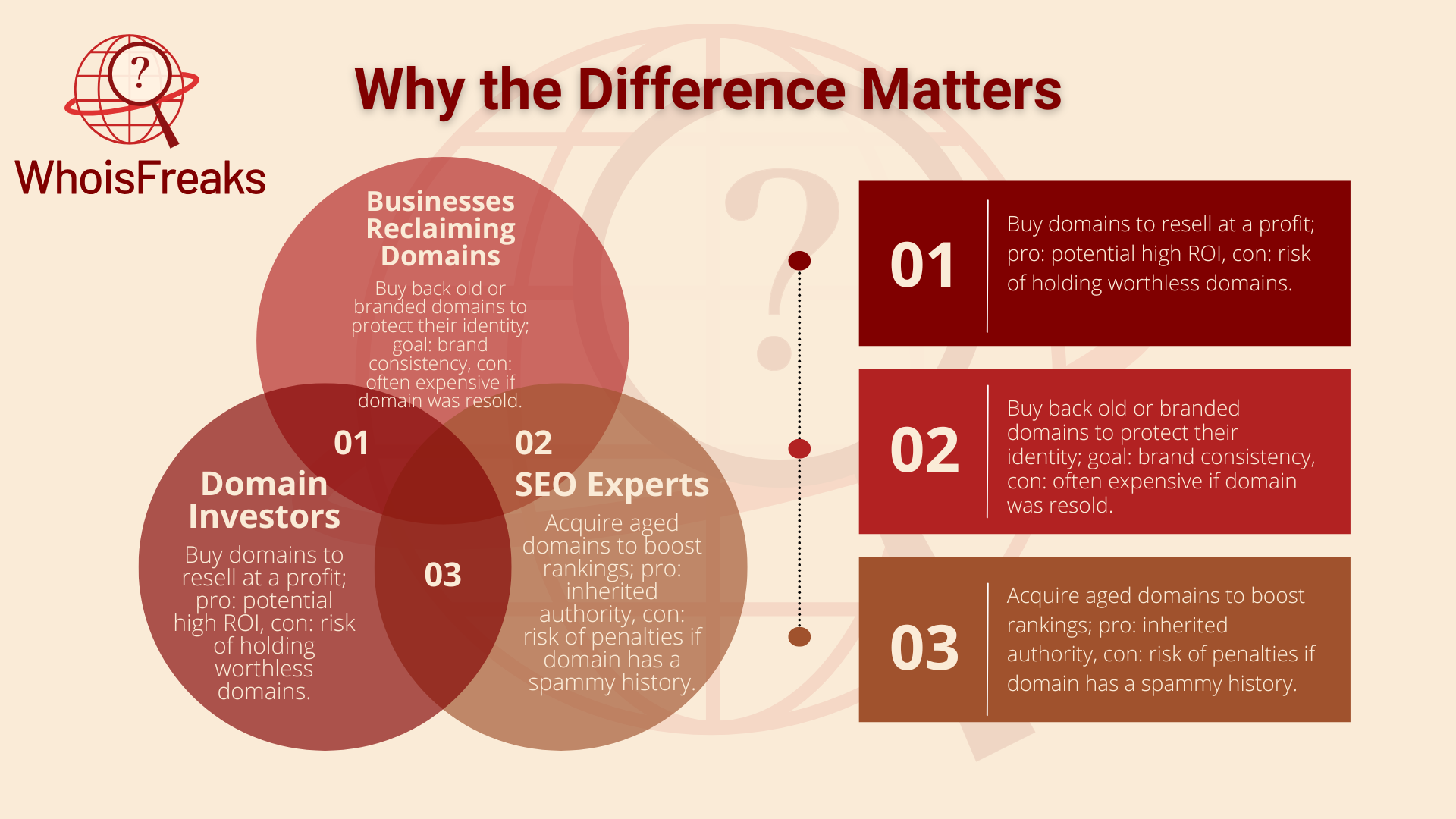
For Domain Investors and Resellers
Expired domains often go up for auction before they reach the dropped stage. This makes them valuable targets for investors looking to buy and resell them for a profit. If you wait until a domain drops, you might miss out on great opportunities or face tough competition from others using automated tools to grab those domains the second they’re available.
For Businesses Trying to Reclaim Old Domains
If your business has a domain that recently expired, knowing the timeline can help you act fast and renew it before it’s gone for good. Once the domain drops, anyone can register it — including competitors or people trying to profit off your brand — which could damage your reputation or online presence.
For SEO Experts
Expired domains can still hold onto their SEO strength, like backlinks and authority, if you reclaim them early. But once they drop, they might lose some of that SEO value or even come with a risky history (like spam or penalties). That’s why it’s crucial to do your research — buying a dropped domain without knowing its background can lead to wasted money or SEO problems.
For Weighing Risks and Opportunities
Knowing what stage, a domain is in helps you judge the risk and potential reward:
- Expired domains: Usually cost more but come with more certainty and less risk of losing the name.
- Dropped domains: Often cheaper but riskier — you may face strong competition, and the domain’s history could be a mixed bag.
How to Find Expired and Dropped Domains
If you’re interested in buying a valuable domain name, it’s important to understand where to look and how to approach both expired and dropped domains. Each type has its own platforms, tools, and strategies and knowing how to navigate them can greatly improve your chances of landing a great domain.
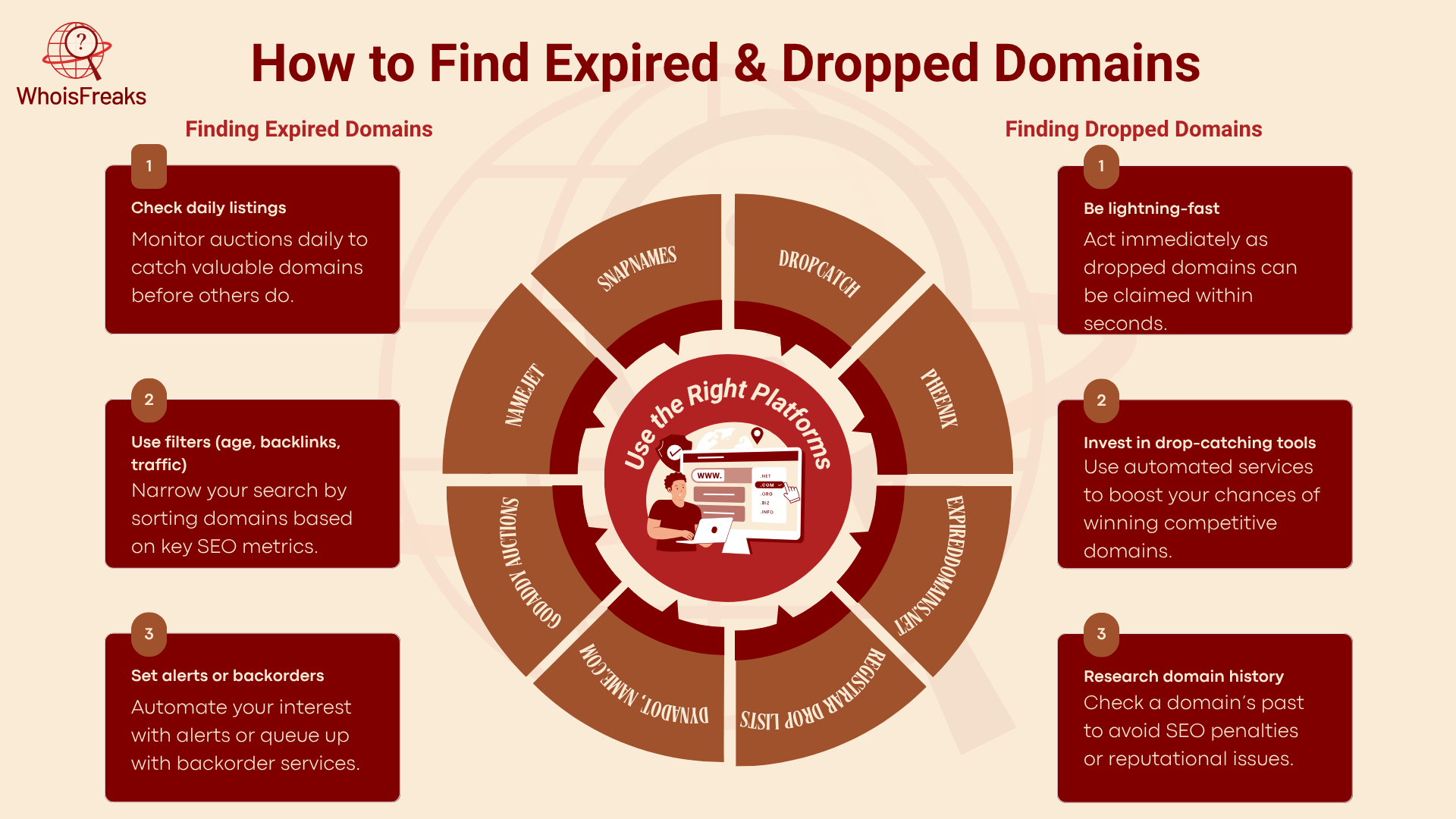
Finding Expired Domains
Expired domains usually show up on auction sites or backorder services before they are fully released to the public. Here are some popular places to keep an eye on:
- GoDaddy Auctions: One of the largest and most well-known marketplaces for expired domains, with a wide range of options.
- NameJet: A popular platform, especially known for premium and high-value domain auctions.
- SnapNames: Specializes in catching expiring domains across many different registrars.
- Dynadot, Name.com, and others: Many domain registrars also have their own lists or marketplaces for expired domains.
Tips for working with expired domains:
- Check listings daily: Good names can sell very quickly, sometimes within hours.
- Use filters wisely: Sort by domain age, backlinks, traffic stats, or other key factors to narrow down the best options.
- Set up alerts or place backorders: This way, you’ll get notified or automatically be in line when a domain you want comes up.
Finding Dropped Domains
When a domain fully drops, it’s open for anyone to register but the competition is intense, especially for valuable names. To boost your chances:
- Use drop-catching services: Platforms like DropCatch, Pheenix, or SnapNames specialize in automatically registering dropped domains the moment they become available.
- Monitor drop lists: Sites like ExpiredDomains.net or Name.com’s daily drop list let you see which domains are about to be released.
- Check with registrars at drop times: Many registrars release dropped domains at set times (usually daytime in their local time zone), so knowing when to look can help.
Tips for working with dropped domains:
- Move fast: Dropped domains are often claimed within seconds, so timing is critical.
- Consider investing in drop-catching tools: If you’re serious about getting high-value names, automated services may be worth the cost.
- Always research the domain’s past: Look into its history to avoid buying a domain with a shady or penalized background.
How to Evaluate a Domain’s Value
No matter if you’re looking at expired or dropped domains, it’s essential to do your homework. Here’s what to check:
- Domain age and authority: Older domains often have more credibility and ranking power.
- Backlink profile: Use tools like Ahrefs or Moz to see if the domain has good-quality backlinks.
- Traffic history: Platforms like SimilarWeb or SEMrush can help estimate past and current traffic levels.
- Past usage: Check the Wayback Machine (archive.org) to see what kind of content or site used to be on the domain.
- Legal or trademark issues: Make sure the domain doesn’t infringe on existing brands or trademarks, which could lead to legal trouble.
Best Practices Before Buying
Buying an expired or dropped domain can bring major benefits — from boosting your online presence to making a smart investment. But without careful research, you could end up with a domain that has a bad reputation, SEO penalties, or legal headaches. Here are some key best practices to follow before making a purchase:
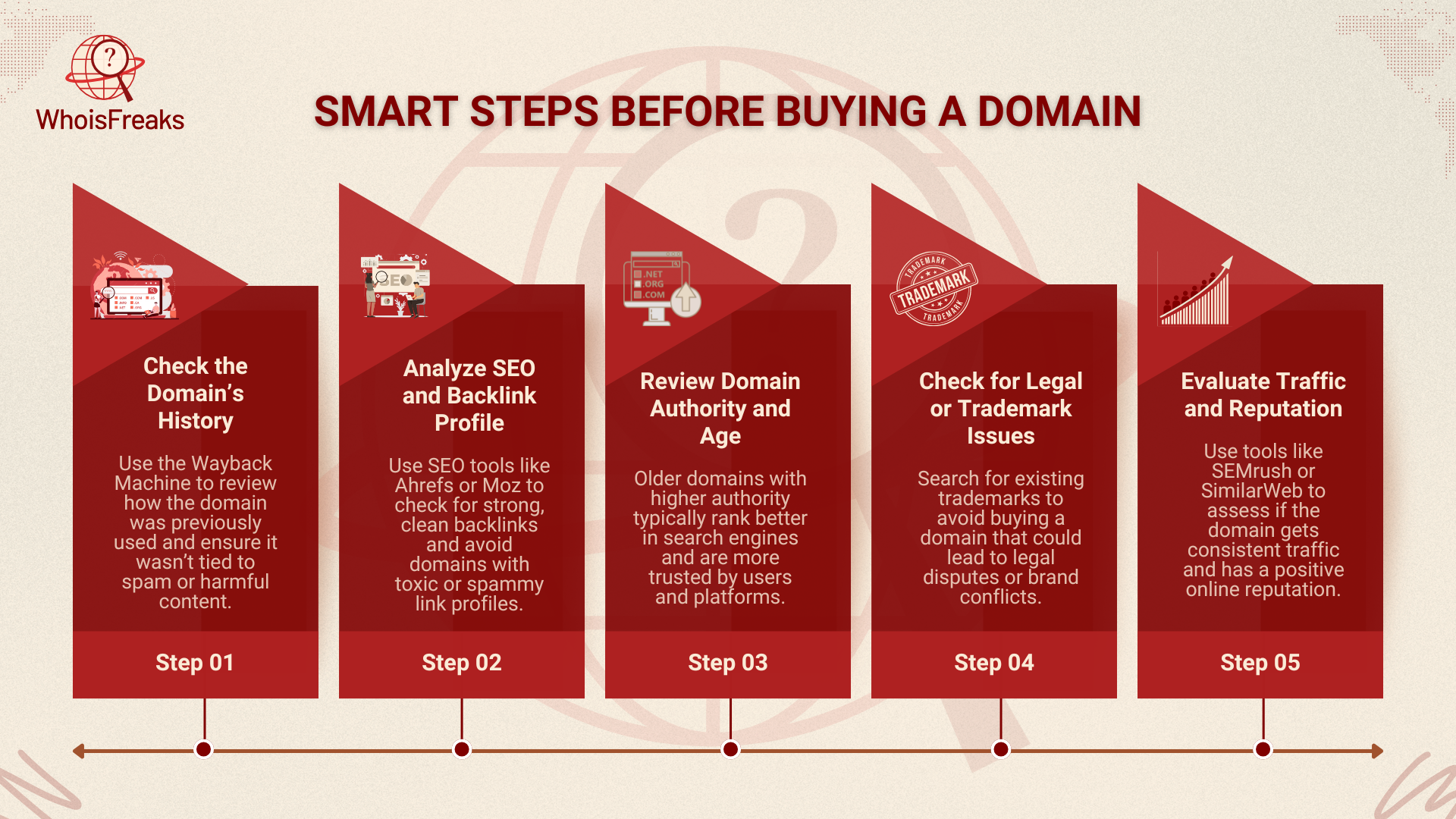
1. Check the Domain’s History
Before buying, it’s crucial to know how the domain was used in the past. Use tools like the Wayback Machine (archive.org) to see archived versions of the site and get a sense of its past content and purpose. This can help you figure out whether the domain was tied to a legitimate business or if it was used for spam, scams, or adult content — all of which can hurt your brand or harm future SEO.
2. Analyze SEO and Backlink Profile
A domain’s search engine value often depends on its backlink profile. Tools like Ahrefs, Moz, or SEMrush can help you check backlinks, referring domains, and overall domain authority. Focus on domains with clean, high-quality links from reputable sites. Watch out for spammy or toxic backlinks, as these can trigger Google penalties and hurt SEO performance. It’s also smart to check if the domain was ever penalized or blacklisted in the past.
3. Check for Legal or Trademark Issues
Don’t overlook the legal side. Always search trademark databases to ensure the domain doesn’t infringe on existing trademarks or well-known brands. Buying a domain that’s too similar to a big company’s name can lead to legal disputes, takedown notices, or even lawsuits. Protect yourself by doing this research upfront it’s a small step that can save you big headaches later.
4. Consider Branding and Market Fit
Beyond technical checks, think about how well the domain fits your goals. Strong domain names are usually short, memorable, easy to spell, and relevant to your business or audience. If you’re an investor, ask yourself if the domain has good resale potential in the future. For businesses, consider whether the name will strengthen your brand and make a lasting impression on customers.
5. Plan Your Pricing and Buying Strategy
A smart buying strategy can help you avoid overpaying or missing out on great domains. For expired domains, look into past auction prices, watch bidding trends, and set a clear maximum bid to stay within budget. For dropped domains, decide if it’s worth using a drop-catching service, especially when going after highly competitive names. Being prepared and acting fast can be the difference between scoring the domain you want or watching someone else take it.
Common Myths and Misunderstandings About Expired and Dropped Domains
When it comes to expired and dropped domains, several myths and misconceptions often mislead buyers and investors. Understanding the reality behind these myths can help you make better decisions and avoid costly mistakes.
When it comes to buying expired or dropped domains, there’s a lot of confusion out there. Many buyers fall for common myths that can lead to wasted money, poor results, or missed opportunities. Let’s break down these myths one by one and explain the real facts in simple terms.
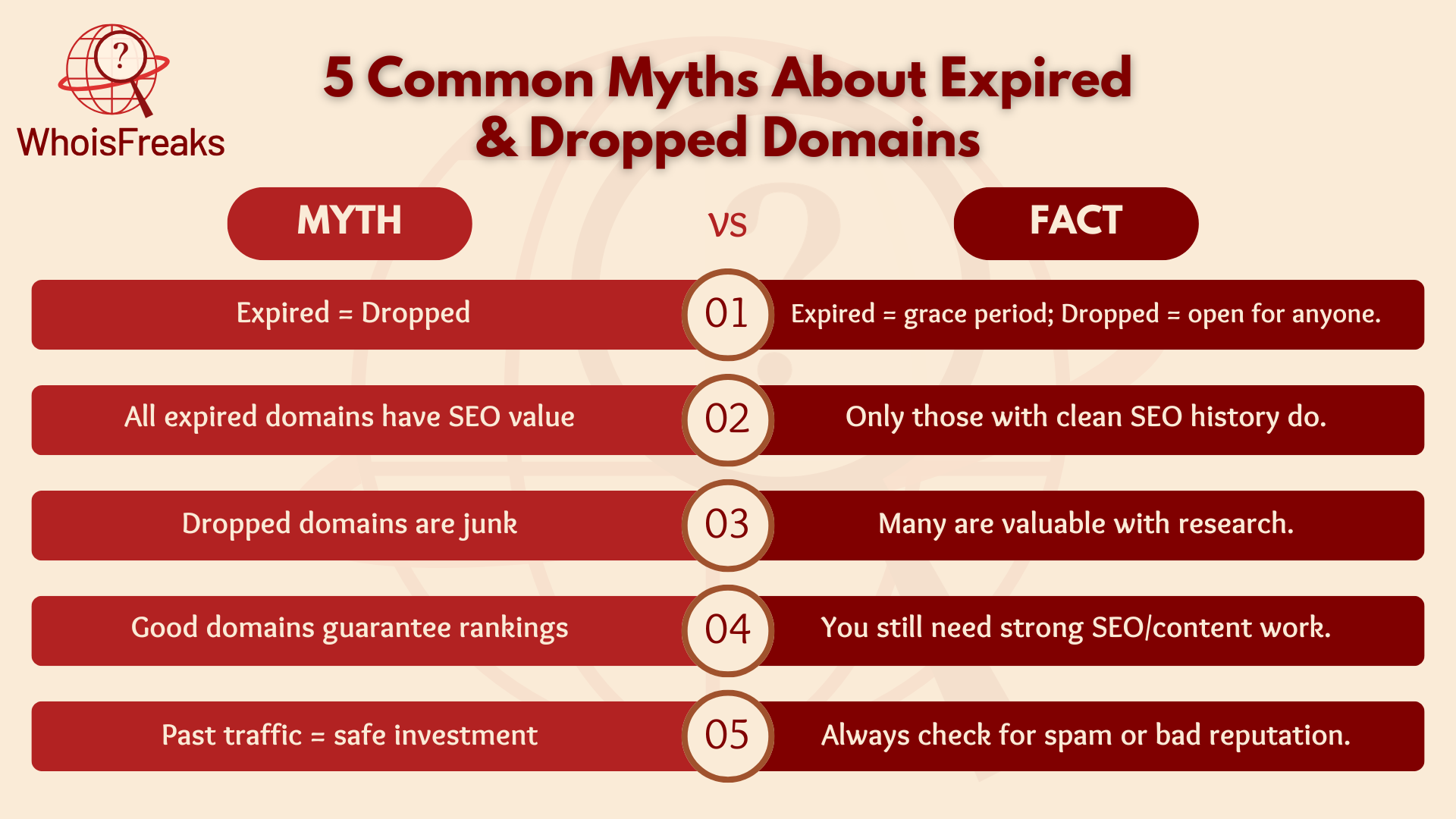
Myth 1: “Expired and dropped domains are the same thing.”
Many people believe that expired and dropped domains are just two words for the same thing, but they actually mean very different stages in the life of a domain name.
An expired domain is one that the owner didn’t renew, but it’s still in a “holding period” called the grace or redemption phase. During this time, the owner can still pay to get the domain back.
A dropped domain, on the other hand, has gone through the full process past grace and redemption and is now completely removed from the registry. At this point, anyone can register it, often on a first-come, first-served basis.
Why this matters: If you confuse the two, you might waste time waiting for a domain to drop when it’s actually going to auction or miss your chance to grab it early.
Myth 2: “All expired domains automatically have SEO value.”
Not every expired domain is a hidden SEO gem. Some people assume that just because a domain has expired, it must come with great backlinks or authority but that’s simply not true.
The value of a domain depends on how it was used in the past. If the domain belonged to a well-respected website, it may still have good backlinks and search engine value. But if it was part of a spammy network, used for black-hat SEO tricks, or penalized by Google, it could hurt your rankings instead of helping them.
Why this matters: Always check the domain’s SEO history before buying. Use tools like Ahrefs, Moz, or SEMrush to check backlinks, and see if it has been penalized or blacklisted.
Myth 3: “Dropped domains are junk and only useful for beginners.”
There’s a common belief that dropped domains are low-quality leftovers but that’s not true. While some dropped domains do have problems, many are still valuable.
In fact, sometimes very good domains get dropped on purpose maybe the business shut down, or the owner no longer needed the domain. These can offer great opportunities for branding, niche projects, or even SEO benefits if the domain still has clean backlinks.
Why this matters: Don’t ignore dropped domains just because they’re “used.” With the right research, you might find a hidden treasure.
Myth 4: “Buying a good domain guarantees instant traffic and rankings.”
Even if you buy a domain that once had a lot of traffic or strong backlinks, that doesn’t mean your new website will automatically get the same success.
Search engines like Google look at more than just the domain name they care about your current content, the purpose of your site, and whether it fits the domain’s history. If you put up completely unrelated content, search engines may not carry over much of the old value. You still need to work on SEO, content, and marketing to build up your site.
Why this matters: Don’t assume a good domain will do all the work for you plan for ongoing SEO and promotion.
Myth 5: “If a domain had past traffic, it’s a safe investment.”
Some domains look great on paper, with good traffic numbers or authority scores but they can come with hidden dangers.
For example, a domain may have been used for spam, malware, fake products, or even illegal activities. This can lead to problems like getting blocked by search engines, landing on email blacklists, or damaging your brand’s reputation.
Why this matters: Always research the domain’s background carefully. Check the Wayback Machine to see its old content and look for signs of shady activity before you buy.
Conclusion
Understanding the difference between expired and dropped domains is key for anyone working in domain investing, SEO, brand management, or digital marketing. While both offer exciting opportunities, they come with different timelines, risks, and strategies for success.
Expired domains, which are still in the grace or redemption period, give you a chance to recover valuable names before they hit the open market though you may face auction competition and higher prices. Dropped domains, on the other hand, are released back into the public pool and can be registered by anyone, but they often come with fierce competition from drop-catching services and carry more uncertainty about their past use.
At the end of the day, whether you’re trying to reclaim an old brand, strengthen your SEO game, or invest in promising digital real estate, the key is to do your homework. With the right research, tools, and understanding of the domain lifecycle, you’ll be in a much stronger position to make smart, informed decisions and get the most value from your domain purchases.
FAQs
1. What is the difference between dropped and Expired Domains?
An expired domain can still be renewed by the owner, while a dropped domain is fully released and open for anyone to register.
2. What does it mean when a domain is dropped?
A dropped domain has gone through its full expiration process and is now available for the public to register on a first-come, first-served basis.
3. Are Expired Domains worth it?
Yes, expired domains can be valuable, especially if they have good backlinks, age, or brand potential — but you should always check their history first.
4. How do I recover an expired domain name?
To recover an expired domain, contact your registrar and renew it during the grace or redemption period before it officially drops.

Software Engineer
A software engineer focused on developing scalable, efficient solutions. Expertise in coding, system optimization, and utilizing advanced technologies for high-performance apps.
Related Posts

Best Expired Domains List: Free Daily Expired Doma...
Discover the best free daily expired domain names to boost your online presence. Explore our curated list and find your perfect domain today!
Published at: Mar 15, 2025

What Are Expired Domains and Why Should You Care?
Expired domains are more than just digital debris—they're a treasure trove of untapped opportunities for marketers, entrepreneurs, and website owners....
Published at: Jan 17, 2025

How WHOIS Data Helps Uncover the History of Droppe...
Dropped domains can be a goldmine for savvy investors, marketers, and businesses looking to enhance their online presence. However, understanding the ...
Published at: Jan 17, 2025